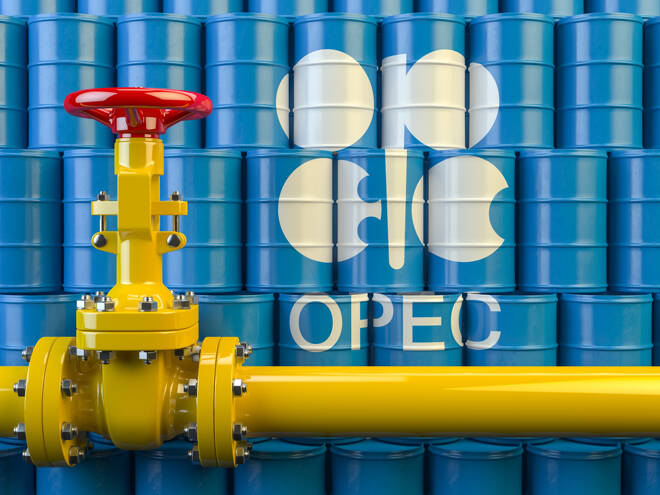Advertisement
Advertisement
Lack of Investments Behind Energy Future Volatility
Published: Oct 22, 2021, 12:23 GMT+00:00
The situation could even become worse very soon, if the ongoing activistic approach taken by investment funds, pension funds or shareholders continues.
The ongoing global energy crunch, at least as proponed by major media outlets, is continuing. European eyes are largely focused on Russian president Vladimir Putin’s statements, while globally Saudi Ministers and US president Biden are making headways too. The current perceived shortage in crude oil and natural gas on the markets however is not caused by only power plays of OPEC+, Putin or Saudi officials, but caused by a structural deficit in investments in upstream oil and gas.
US president Biden is blaming OPEC+ for increased higher prices at the pump. He indicated yesterday also that he is assessing the option of “go in the [Strategic] Petroleum Reserve and take out and probably reduce the price of gas maybe 18 cents or so per gallon”. He however needed to admit that that still doesn’t remove higher price settings from the US markets.
Biden reiterated that “gas prices relate to a foreign policy initiative that is about something that goes beyond the cost of gas … That’s because of the supply being withheld by OPEC”. At the same time, European leaders and even the EU Commission is looking at Russian president Putin to open up the valves of natural gas pipelines to increase the flow to the union. Confronted by lower natural gas storage volumes, and price levels still 6-8 times higher than in 2020, Europeans feel that Putin holds all the cards.
Both parties, Biden and EU, are only partly right. Market fundamentals have been largely changed with a big bang, as the OPEC+ export strategy has been successful, against the odds of some analysts, removing not only supply but also part of the oil storage glut. At the same time, OPEC+ has been supported by an unexpected level of global economic growth pushing demand back to before 2020 levels. For natural gas, and even LNG, the same picture can be painted, even that there is no OPEC version for natural gas in place. Demand has increased substantially, while Europe’s main supplier Russia is struggling or unwilling to deliver.
Geopolitical issues are playing a major role, as Putin clearly has indicated by pushing for a Nordstream2 decision by the EU. Some however forget that Europe has been confronted by the removal of the Dutch Groningen gas field production (the Saudi gas version in EU), while Norway is also hitting its own constrains. A combination of lower European supplies, combined with higher global demand (China, India) for natural gas and LNG has pushed prices to never seen levels.
As Saudi Arabia’s minister of finance Mohammed Al-Jadaan however stated on US TV channel CNBC, the Kingdom is not targeting very low oil prices or pushing for even higher oil prices. Al Jadaan made a very potent point, low oil prices destroy or paralyze energy investment in general, no party is looking for this situation. He reiterated that very low oil prices are undesirable as they negatively affect and paralyze oil investments, which leads to a real energy crisis, as what is happening currently with gas.
This aspect has not been analyzed by most media sources. The attractiveness of taking a geopolitical or geo-economic position in the current energy crisis is clear, but not the Holy Bible of truth. Both OPEC+ members (oil) but also Russia as gas exporter have warned again and again that underinvestment in upstream and downstream will lead to destabilization of markets and risks higher price settings in the end. As Putin rightly stated to the press, underinvestment could lead to undersupply similar to current gas market conditions.
The Russian leader stated also that several OPEC+ are not able to increase production quickly due to lack of investments. He indicated that between 2012-2016 investments in oil were around $400 billion per year, while at present only $260 billion is available. The latter situation at present is also clearly visible in natural gas worldwide.
Not only OPEC+ producers have stated the latter, mainstream oil and gas investment consultants have again and again said the same. The current situation is clearly now a man-made disaster, which we can’t remove quickly from the connotation.
The situation could even become worse very soon, if the ongoing activistic approach taken by investment funds, pension funds or shareholders continues. The hydrocarbon divestment tsunami is going to hit mostly listed-private companies, forcing them not only to divest oil and gas assets, but also to invest more in renewables. By the latter approach the strategy is acting as a two-edged sword, cutting from both sides in future oil and gas production. The upcoming COP26 is already expected to be a major anti-hydrocarbon stage, resulting in even more pressure, while global demand is expected to increase substantially still the next decade. According to the US Department of Energy’s EIA demand for oil and gas will increase even until 2050!.
For a look at all of today’s economic events, check out our economic calendar.
About the Author
Cyril Widdershovenauthor
Dr. Widdershoven is a veteran Energy market expert and holds several advisory positions at various international think-tanks and global Energy firms.
Advertisement
